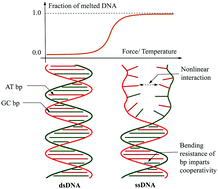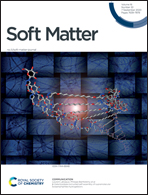Statistical mechanics of a double-stranded rod model for DNA melting and elasticity
Abstract
The double-helical topology of DNA molecules observed at room temperature in the absence of any external loads can be disrupted by increasing the bath temperature or by applying tensile forces, leading to spontaneous strand separation known as DNA melting. Here, continuum mechanics of a 2D birod is combined with statistical mechanics to formulate a unified framework for studying both thermal melting and tensile force induced melting of double-stranded molecules: it predicts the variation of melting temperature with tensile load, provides a mechanics-based understanding of the cooperativity observed in melting transitions, and reveals an interplay between solution electrostatics and micromechanical deformations of DNA which manifests itself as an increase in the melting temperature with increasing ion concentration. This novel predictive framework sheds light on the micromechanical aspects of DNA melting and predicts trends that were observed experimentally or extracted phenomenologically using the Clayperon equation.



 Please wait while we load your content...
Please wait while we load your content...